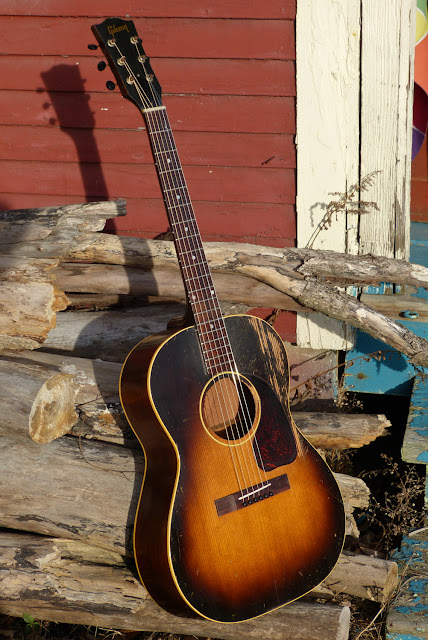1950 Gibson LG-1 Flattop Guitar
I haven't had many chances to work on LG-1s over the past few years. The last one I remember clearly is a '56 I worked-on for a local fellow. This one came in via consignment and, I think, it's got the stuff. The washboarded upper bout on the top tells the tale of many late nights strumming-away and the overall condition tells of a friend that was mostly looked-after. It's also mostly-original, though the bridge, pins, and saddle are replaced and the buttons on the tuners are, too.
LG-1s are what I consider "the Kalamazoo for folks who don't truly like Kalamazoos." They're ladder-braced and have some of the roosty, woody, plain-spoken and direct "fingerpicked blues" tone of a KG-14, but they're "wider-sounding" on the low-end and a little chunkier in the mids. They make great "folk" guitars, and as I've mentioned before, there must be a reason Elvis used LG-1s throughout his movies. I know that I like the sound!
Work needed to be done on this, however, and in the end I gave it a neck reset, a fresh new rosewood bridge, new bone saddle, new ebony pins and endpin, a fret level/dress, and good setup. I also cleated a barely-visible small hairline crack on the top (near the pickguard), reglued a couple of back braces, and cleated a longer hairline crack on the back. The owner of the guitar wasn't thinking a neck reset was in order, but I'm glad I did it -- it was right on the borderline. Action is 3/32" EA and 1/16" DGBE at the 12th fret.
It's hard to beat Gibson sunbursts, isn't it?
The top is spruce and the back and sides are mahogany.
The nut is original plastic and 1 11/16" in width. This has a smaller-profile C-shaped neck compared to the '49 LG-2 I just posted, but still definitely "medium" in today's context.
The frets are the original, smallish, Gibson wire. They have good height and my level/dress job did not need to remove much material. This has a radius just-under 12" -- and feels good. The board is Brazilian rosewood and has pearl dots.
My new Indian rosewood bridge is a little thicker than the original Gibson bridge, though there's a little over 1/16" of adjustment room left and the slot is drop-in, so adjustments are easy. The pins are all ebony.
Pretty, no? The "color change" is just reflection in the finish.
Here's that hairline crack on the back. For the life of me, I could not find it on the inside. Still, I put some cleats in there over it and sealed the crack externally, too.
The patina and overall look of the guitar is very handsome.
A too-large, but functional hard case is included with it.























Comments